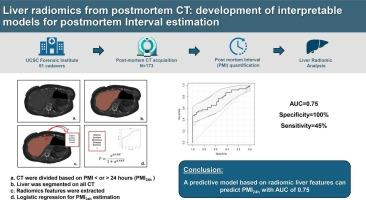从死后CT估计肝脏放射组学:发展可解释的死后间隔估计模型。
IF 2.7
3区 医学
Q1 RADIOLOGY, NUCLEAR MEDICINE & MEDICAL IMAGING
Physica Medica-European Journal of Medical Physics
Pub Date : 2025-10-01
DOI:10.1016/j.ejmp.2025.105186
引用次数: 0
摘要
尸检计算机断层扫描(PMCT)越来越多地用于法医调查,提供了一种非侵入性和客观的方法来估计尸检间隔(PMI)。本研究旨在开发和外部验证放射学模型,利用PMCT扫描的肝脏放射学特征来区分24小时内和24小时外的死亡。方法:对51具尸体进行回顾性分析,用于模型开发,并在80个独立病例中进行验证。在训练集中,分析了173个不同pmi的PMCT扫描。人工分割肝脏,提取40个放射学特征,包括统计学、形态学和分形。使用类内相关系数(ICC)对自动轮廓分割进行鲁棒性评估。PMI被二分类为≤24和> 24 h。单因素分析确定了预测特征,并从显著变量建立了逻辑回归模型。采用受试者工作特征(ROC)曲线评价模型的性能,灵敏度和特异性均在最佳阈值。结果:四个特征与PMI显著相关,其中肝脏偏度最具预测性(p = 9.13 × 10-4)和稳健性(ICC = 0.75)。基于偏度的逻辑回归模型的AUC为0.75 (95% CI: 0.65-0.86),在最佳阈值下特异性为100%,可靠地识别24小时后的死亡。添加第二个特征并没有提高性能(p = 0.54, DeLong检验)。外部验证证实了偏度模型的特异性(在最佳阈值下为70%)。结论:从PMCT中提取的肝脏偏度显示出作为识别24小时以上死亡的生物标志物的潜力,其性能在一个独立队列中得到证实。本文章由计算机程序翻译,如有差异,请以英文原文为准。

Estimation liver radiomics from postmortem CT: Development of interpretable models for postmortem interval estimation
Introduction
Postmortem computed tomography (PMCT) is increasingly used in forensic investigations, offering a non-invasive and objective approach to estimating the postmortem interval (PMI). This study aimed to develop and externally validate radiomic models to distinguish deaths within versus beyond 24 h, using liver radiomic features from PMCT scans..
Methods
A retrospective analysis was performed on 51 cadavers for model development and validated on 80 independent cases. In the training set, 173 PMCT scans across different PMIs were analyzed. The liver was manually segmented, and 40 radiomic features—statistical, morphological, and fractal—were extracted. Robustness to segmentation variability was assessed with autocontoured segmentations using the Intraclass Correlation Coefficient (ICC). PMI was dichotomized as ≤ 24 versus > 24 h. Univariate analyses identified predictive features, and logistic regression models were built from significant variables. Model performance was evaluated with receiver operating characteristic (ROC) curves, with sensitivity and specificity at the optimal threshold.
Results
Four features were significantly associated with PMI, with liver skewness emerging as the most predictive (p = 9.13 × 10−4) and robust (ICC = 0.75). A logistic regression model based on skewness achieved an AUC of 0.75 (95 % CI: 0.65–0.86) and 100 % specificity at the optimal threshold, reliably identifying deaths beyond 24 h. Adding a second feature did not improve performance (p = 0.54, DeLong test). External validation confirmed specificity of the skewness model (70 % at the optimal threshold).
Conclusion
Liver skewness extracted from PMCT shows potential as a biomarker for identifying deaths beyond 24 h, with performance confirmed on an independent cohort.
求助全文
通过发布文献求助,成功后即可免费获取论文全文。
去求助
来源期刊
CiteScore
6.80
自引率
14.70%
发文量
493
审稿时长
78 days
期刊介绍:
Physica Medica, European Journal of Medical Physics, publishing with Elsevier from 2007, provides an international forum for research and reviews on the following main topics:
Medical Imaging
Radiation Therapy
Radiation Protection
Measuring Systems and Signal Processing
Education and training in Medical Physics
Professional issues in Medical Physics.

 求助内容:
求助内容: 应助结果提醒方式:
应助结果提醒方式:


